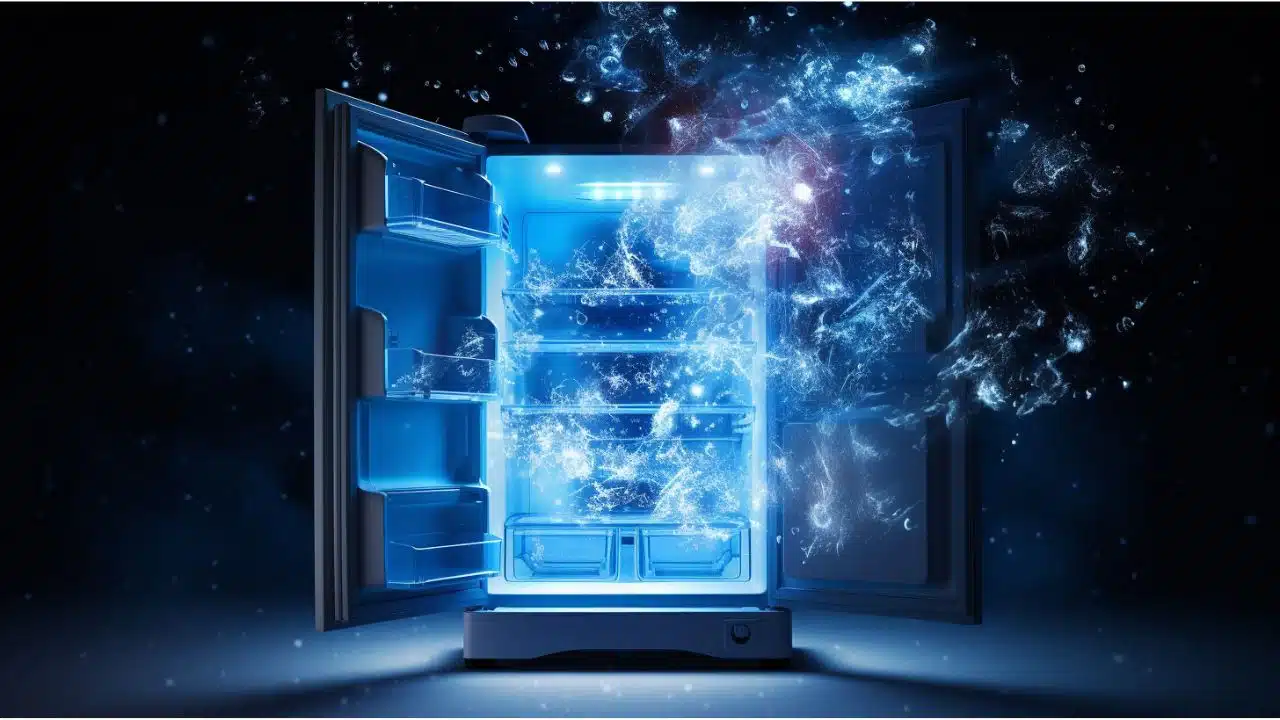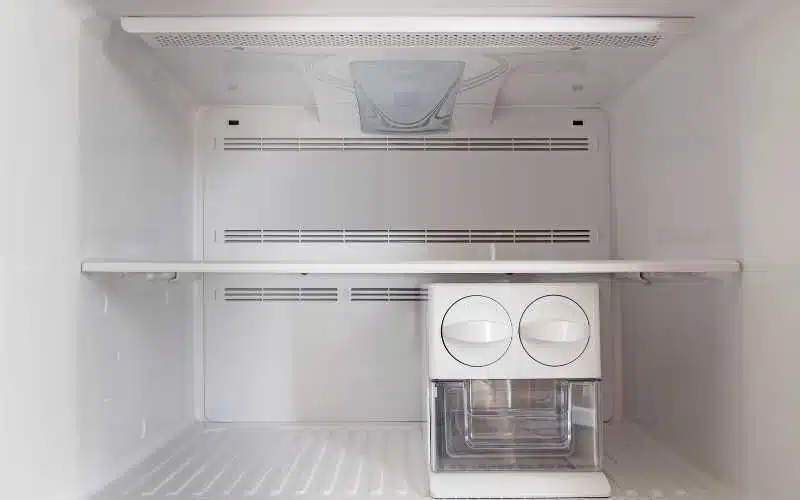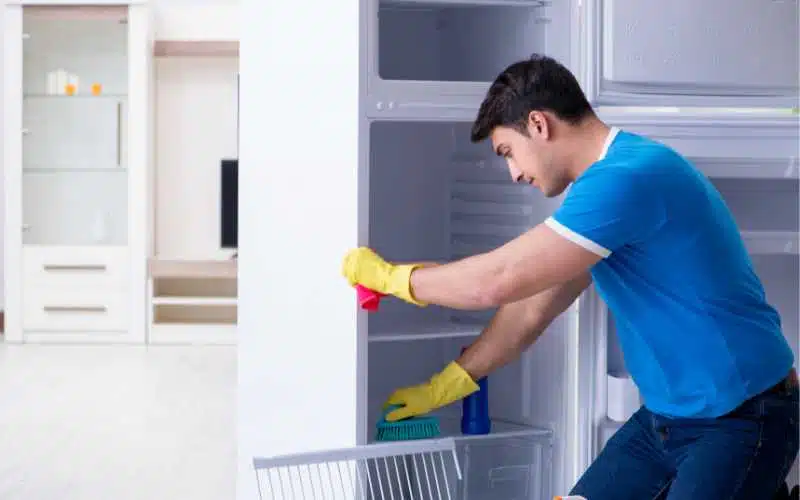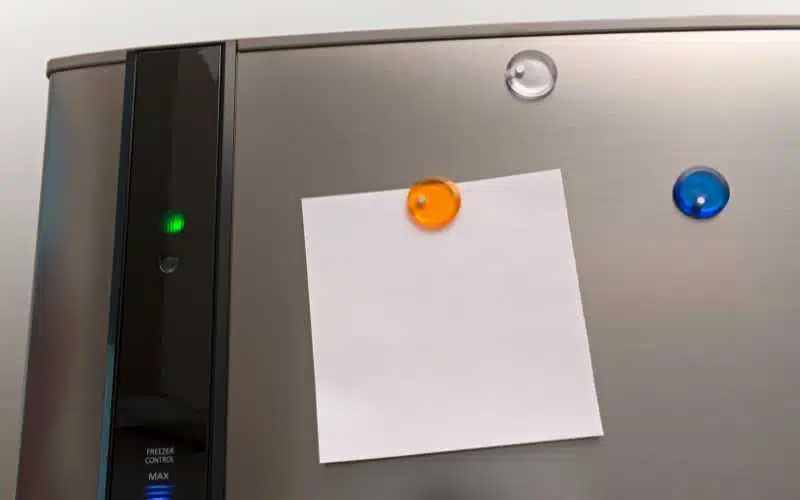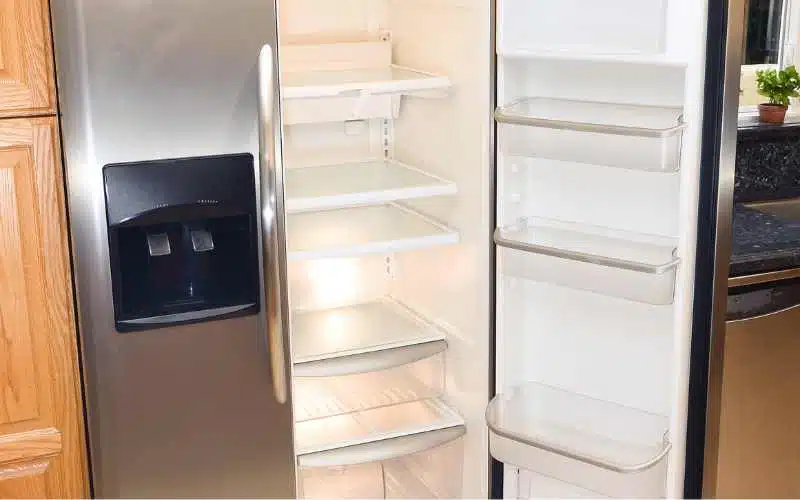If you have a GE French door refrigerator, there are chances it also has a nice maker. This aspect of the refrigerator is a notable part of your unit.
With an ice maker, you can get ice whenever you want. You may have to reset your refrigerator’s ice maker. Good thing; it’s an easy process.
To reset your ice maker, find the power button in the front of the GE refrigerator ice maker and switch it off. Leave it off for half a minute. Then, turn it back on and find the feeler arm on the ice maker. Push up the feeler arm three times to reset the ice maker.
How Do I Reset My GE French Door Refrigerator’s, Ice Maker?
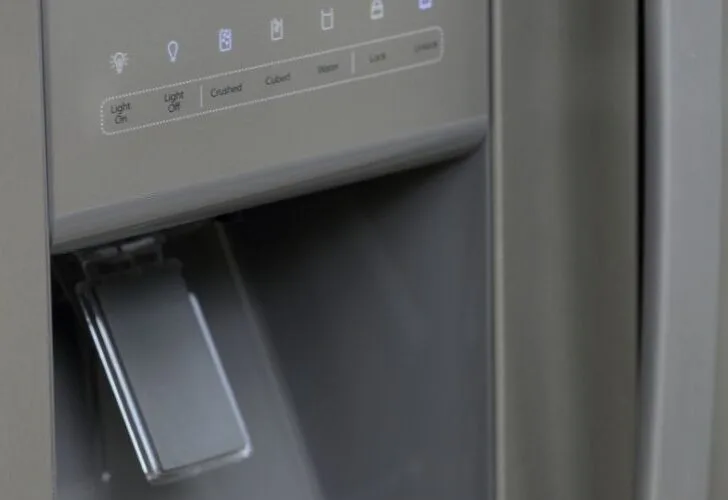
Don’t give up if your GE ice maker isn’t producing ice as it should. It might only be necessary to reset the ice machine, but how do you accomplish that?
Let’s look at the procedures you must adhere to.
#1. Take Out its Ice Bucket
You must first empty the fridge’s ice bucket. Find the release key or handle on the front side of the refrigerator’s ice maker, then pull it down to accomplish this.
The bucket ought to pop out immediately. You can remove the bucket from your fridge depending on it.
#2. Find the Switch for the Power
Right on the back of the ice maker will be the power switch. Place the power switch in the “OFF” position once you’ve found it.
Wait for 30 seconds immediately after switching the power switch button off, then turn it back on so that the fridge’s ice maker has a chance to reset.
#3. Restart the Ice Maker
Again, the icemaker should be turned on by turning the power switch to the “ON” position after waiting 30 seconds.
#4. Draw the Feeler Arm Up
Pushing the fridge’s feeler arm three times up is the last step. The plastic component that protrudes from the ice maker and signals when to cease producing ice is known as the feeler arm.
The ice maker can be reset by pushing up on the feeler arm three times, at which point it will resume producing ice.
Keep reading to learn the answers to some frequently asked questions concerning GE ice makers if the reset doesn’t fix your issue.
Where Is the Reset Button on GE Ice Maker?
Some GE ice makers do not have a reset button. To reset one, try turning the ice maker off at the power source.
Sometimes, the reset button is on the right side of the refrigerator’s ice maker. It is usually a clear, rectangular rubber button at the refrigerator’s bottom.
In some other GE refrigerator ice makers, you can find the reset button at the ice maker’s bottom.
When you remove the ice tray, there’ll be a red button. The red button there is the reset button. Different brands of refrigerators have different locations of their reset buttons.
The table below will guide you through funding the ice maker for their different brands of refrigerators.
| Brand | Reset Button Location |
|---|---|
| Samsung | The base of the ice tray. |
| Whirlpool | The bottom of the ice maker |
| Frigidaire | Front of the ice maker |
How Do I Manually Reset My GE French Door Refrigerator Ice Maker?
To view the evaporator of the ice maker, open the front panel and raise the ice guide. Before moving on to the next stage, let any ice on the evaporator melt.
After unplugging the device, wait ten seconds. Press the ON button and re-plug the device.
#1. Activate the On/Off Switch
When you plug the refrigerator back in, turn the switch on, and the ice machine should start operating.
The GE refrigerator also features an on/off button for the ice makers, but you can reach it without removing the ice tray. The front cover doesn’t need to be taken off.
#2. Remove the Refrigerator’s Plug
You can try this easy process to reset your ice maker if it lacks a reset button. Although it’s advised for GE ice producers, it won’t do any harm if it doesn’t work on your particular model.
Reconnect the refrigerator’s power after a 30-second delay. After power has been restored for 15 seconds, press the feeler arm three times in quick succession.
This solution should prompt the ice maker to fill the reservoir with water to begin ice production.
Why is My GE French Door Refrigerator Not Making Ice?
You should first locate the ice maker shutoff switch on your GE refrigerator if it isn’t producing any ice.
This portion of the appliance should be turned off and left off for at least 30 seconds.
Although a reset does not fix ice maker issues each time, it’s usually worthwhile to try before asking for assistance.
You can try a few additional things if your GE fridge’s ice maker is still not producing ice after a reset.
Find the arm feeler, a stout wire inside the ice machine. It signals the device to stop creating ice.
Restore the ice maker’s electricity. Other reasons why your GE French door refrigerator isn’t making ice could be:
#1. Unplugged Icemaker
Although it should go without saying, occasionally, people fail to turn on their ice machine.
Therefore, make sure the ice machine is turned on before starting again. Find the power switch on the back of the ice maker and turn it to the “ON” position to accomplish this.
#2. Temperature Maintenance
The refrigerator and the ice maker must be maintained at the right temperature to create ice.
If your efforts to reset the appliance are unsuccessful and there is no ice stuck in the chute, it’s conceivable that your temperature settings are off.
See the owner’s manual for your appliance to determine the appropriate temperature for your refrigerator and ice maker.
A sensor problem may be to blame if the temperature reads correctly, but no ice is produced. You can get help from a repairman to determine if this is the problem.
#3. Maintaining the troubleshooting
You might need to acquire a replacement GE ice maker if your attempts to troubleshoot your refrigerator’s ice maker are unsuccessful.
See the owner’s manual included with your appliance for the manufacturer’s phone number.
Which ice maker you need to order for your specific refrigerator can be confirmed for you by a GE representative.
#4. Clogged Water Filter
The water filter in your ice maker may be clogged, which would stop it from producing ice. The ice maker can’t produce ice if the water flow is restricted by clogging in the water filter.
You should change water filters after six months; however, you can change them earlier if you think they’re clogged.
#5. Insufficient Water Supply
A GE ice maker may not produce ice due to insufficient water supply. Water may not reach the ice maker if the water line is frozen, kinked, or constrained.
Find the input valve behind the refrigerator and ensure there are no leaks before checking the waterline. You’ll have to change the valve if it’s leaking.
Then, trace the water line to check whether it is frozen or kinked and if the valve is not dripping. Inadequate water pressure may also be the cause of the problem.
Start by determining whether the main shut-off valve’s water pressure exceeds 40 psi. Then, you’ll have to contact a plumber to fix the issue if it’s not.
#6. High Temperature
The refrigerator’s ice maker may not be able to produce ice if the freezer is too warm. If your freezer is placed higher than the recommended 0°F, it can cause your ice maker’s malfunction.
Find the thermostat, and crank it down to lower the freezer’s temperature. Once the freezer has reached the proper temperature, check to see if the ice maker is functioning.
Additionally, confirm that its lever arm—a plastic protrusion from the fridge’s ice maker—is actually in the bottom position.
This level arm determines when your ice maker manufactures ice; if it is in the upward position, the ice maker will not manufacture any ice.
#7. Door Switch Malfunction
As a safety measure, the fridge’s door switch stops the refrigerator’s icemaker from producing ice when your freezer door is left open.
The ice machine might not function when the door switch develops a fault. To test the switch, open the freezer’s door, then apply pressure using your finger.
If you do not notice a click, it’s likely that its switch is broken and needs replacement.
#8. Your Freezer Is Overstuffed
Overstuffed freezers may make it impossible for the fridge’s ice maker to function.
That’s because an overstuffed freezer won’t have enough cold air circulating to allow the ice maker to produce enough ice, which is necessary for making ice.
Additionally, it may impede the components of the refrigerator’s ice maker, preventing proper operation.
Remove some of the food from your freezer if it’s too full to allow your ice maker to function.
#9. A Defective Water Inlet Valve
The water inlet valve can be broken if the ice maker isn’t receiving water. Behind the refrigerator is a water inflow valve that prevents water from reaching the ice maker if it isn’t functioning properly.
Disconnect the electricity and shut off the water supply to the refrigerator before testing the water inlet valve.
Next, check the continuity of the water entry valve with a multimeter. The resistance of a water inlet valve should be between 500 and 1500 ohms. The valve must be changed if there is no continuity.
#10. There Aren’t Sufficient Stocks in the Freezer
The ice maker won’t function properly if there isn’t enough food inside the freezer. The reason for this is the ice maker won’t be able to function effectively.
After all, the freezer has to do more work to keep the required temperature. The fridge’s ice maker should start producing ice after placing more stock in the freezer.
#11. Breaks in the Ice Tray
This could be the issue if your refrigerator’s ice maker has a switching ice tray.
As time goes on, the fridge’s ice tray can get cracked, and this causes the ice to break and stop the refrigerator’s ice maker from functioning properly.
To repair this, remove the fridge’s ice tray and replace it with another. You can always get ice trays in many home product stores around.
You may require the assistance of a professional refrigerator repair repairperson to install your ice maker replacement. GE technicians may be able to help you fix such technical problems.
Conclusion
Every homeowner’s best friend is an ice maker, especially in the summer. If it stops making ice, it can be an important issue.
Several things can make the ice maker stop functioning, but luckily, most of them are easy to repair.
